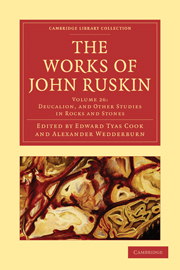Book contents
- Frontmatter
- Contents
- LIST OF ILLUSTRATIONS
- INTRODUCTION TO THIS VOLUME
- I ON THE FORMS OF THE STRATIFIED ALPS OF SAVOY (1863)
- II NOTES ON THE SHAPE AND STRUCTURE OF SOME PARTS OF THE ALPS, WITH REFERENCE TO DENUDATION (1865)
- III ON BANDED AND BRECCIATED CONCRETIONS (1867–1870)
- IV DEUCALION: COLLECTED STUDIES OF THE LAPSE OF WAVES AND LIFE OF STONES (1875–1883)
- V ON THE DISTINCTIONS OF FORM IN SILICA (1884)
- VI CATALOGUES OF MINERALS
- VII THE GRAMMAR OF SILICA (not hitherto published)
- APPENDIX: LETTERS, ADDRESSES, AND NOTES
- I NOTICE RESPECTING SOME ARTIFICIAL SECTIONS ILLUSTRATING THE GEOLOGY OF CHAMOUNI (1858)
- II LETTERS TO THE “READER” ON THE CONFORMATION OF THE ALPS (1864)
- III JAMES DAVID FORBES (1874)
- IV A LECTURE ON STONES (1876)
- V THE ALPINE CLUB AND THE GLACIERS (1878)
- VI INTRODUCTION TO W. G. COLLINGWOOD'S “LIMESTONE ALPS OF SAVOY” (1884)
- VII THE GARNET (1885)
- VIII A GEOLOGICAL RAMBLE IN SWITZERLAND
- INDEX
- Plate section
VII - THE GARNET (1885)
Published online by Cambridge University Press: 05 March 2012
- Frontmatter
- Contents
- LIST OF ILLUSTRATIONS
- INTRODUCTION TO THIS VOLUME
- I ON THE FORMS OF THE STRATIFIED ALPS OF SAVOY (1863)
- II NOTES ON THE SHAPE AND STRUCTURE OF SOME PARTS OF THE ALPS, WITH REFERENCE TO DENUDATION (1865)
- III ON BANDED AND BRECCIATED CONCRETIONS (1867–1870)
- IV DEUCALION: COLLECTED STUDIES OF THE LAPSE OF WAVES AND LIFE OF STONES (1875–1883)
- V ON THE DISTINCTIONS OF FORM IN SILICA (1884)
- VI CATALOGUES OF MINERALS
- VII THE GRAMMAR OF SILICA (not hitherto published)
- APPENDIX: LETTERS, ADDRESSES, AND NOTES
- I NOTICE RESPECTING SOME ARTIFICIAL SECTIONS ILLUSTRATING THE GEOLOGY OF CHAMOUNI (1858)
- II LETTERS TO THE “READER” ON THE CONFORMATION OF THE ALPS (1864)
- III JAMES DAVID FORBES (1874)
- IV A LECTURE ON STONES (1876)
- V THE ALPINE CLUB AND THE GLACIERS (1878)
- VI INTRODUCTION TO W. G. COLLINGWOOD'S “LIMESTONE ALPS OF SAVOY” (1884)
- VII THE GARNET (1885)
- VIII A GEOLOGICAL RAMBLE IN SWITZERLAND
- INDEX
- Plate section
Summary
1. In the last chapter, I distinguished granulated rocks from composite rocks, of which the most important to the general reader are of course those in which one of the component substances may be sometimes separable in the form of a gem. Of these, one of the most interesting masses in the world is the mountain with the pretty name, Adula, which rises in the midst of the St. Gothard Pass, above the plain, I believe, on which the old Hospice still stands. In the substance of that single mountain are found, in confused crystals, some fifteen or twenty (I will count presently) different minerals, all of them interesting, and five precious; namely, first, the one which takes its name from the mountain, Adularia—in the finest conditions of it, used by jewellers under the name of moonstone; secondly, the red garnet, which is the subject of our immediate inquiry; thirdly, the most beautiful rock-crystal that can be found in the world; fourthly, the jewel described by Saussure under the name of Sappare, as blue as a pale sapphire, and much brighter than any sapphire, if left in its natural crystal; and, lastly, the mineral called, I know not why, but very prettily, Tourmaline, sounding as if it were the Tower of Mechlin, and indeed forming towers, when perfectly crystallized, which uninformed fairies might take for the Tower of Giotto built of ruby.
- Type
- Chapter
- Information
- The Works of John Ruskin , pp. 575 - 576Publisher: Cambridge University PressPrint publication year: 2010First published in: 1906



